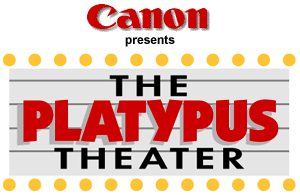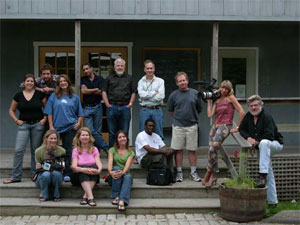 |
→ October 2005 Contents → Platypus Theater
|
 | |||||||||
The Long Road to Platypus
October 2005
|
|||||||||
|
When I was first asked to help produce television to go with one of my newspaper stories, I was outraged.
It was late 2002. A staff writer for the Hartford Courant, in Connecticut, I'd just spent six weeks observing two autistic little boys. This was fly-on-the-wall stuff that we journalists live for, and I'd gotten close enough to get puked on by four-year-old Gabriel. Hell, I'd even listened to the parents' late-night pillow talk while crouched on their bedroom floor. And now the newspaper wanted me to share my hard-won access because of something called synergy?
I told the mother of the boys, Beth, about the request for a video version of the story and confidently waited for my prize subject to nix the idea. But Beth wasn't so hasty. The access I congratulated myself on winning was actually freely given, because Beth and her husband Larry wanted to share their story. If television could reach a greater audience, the family would welcome a video camera into the home, Beth told me.
What could I say? I held my nose and told Tony Bacewicz, a Hartford Courant photographer-turned-video-journalist, that he could start shooting. As the weeks passed, Tony amazed me. A graduate of Platypus, he told, through images and sound, a wonderful story of parents with severely autistic sons, who somehow managed to hold it together to be just a normal family. When his video ran on a local Fox affiliate and then posted on the Courant's Web site, I had to admit that in many ways, it was more powerful than my best writing.
I suddenly saw the possibility for video in every story I wrote. I begged to have Tony work with me, but this usually wasn't possible. In despair, I purchased my own camera in 2003, a Sony 3-chip TRV-950, with the idea that I would shoot my own stories. My husband, Michael Kodas, a photographer for the Hartford Courant, told me that real photographers bring their gear everywhere, so I turned my purse into a camera bag and brought it on assignments and out for dinner, bouncing along with my wallet, cell phone, Palm Pilot and makeup. No tripod, no external microphone, no lighting gear and certainly no plan for how to shoot anything. Few of the wobbly images I captured could be edited into a story.
As for the result ... well, let's just say I came home convinced of the need for professional video training. I signed up for the Platypus Course to be held at the Maine Photographic Workshops in August 2005, and impatiently waited almost a year for the course to roll around.
Having worked hard building a solid reputation for failure, I was especially nervous about Dirck Halstead's legendary critiques. He'd named his workshop after the duck-billed, egg-laying mammal found in Australia because it is an ancient creature that survived by adapting, just like today's media professionals must adapt to a podcasting, video streaming world. But what if I proved to be like the dinosaurs, who surely realized their world was getting damn cold, but failed to come up with a plan? My anxiety increased when Dirck handed out the cameras on the first day.
The Canon XL2 is a reputedly a wonderful camera. It is also, in my mind, about the size of a machine gun. Pointing it feels like an act of war, at least for a shooter who doesn't understand the delicate collaboration between a photographer and subject. In my first attempts at b-roll, all of my subjects were shot from behind, because at crucial moments, when I needed to face the action, my nerve failed.
"Are you a photographer?'' Dirck asked tactfully.
I was perched uncomfortably on a high stool at the front of the classroom, viewing my footage for the first time as the rest of the class looked on.
"No,'' I replied.
"I can tell,'' Dirck said.
I finally mustered up the courage to ask Dirck if this mattered. If the answer was that I was hopelessly behind, I wasn't sure I wanted to hear it.
"Don't worry about it,'' Dirck said.
The photographers will always do better on beauty shots, he said. But video is not primarily about beauty. It is a temporal medium rather than a spatial one. In short, it is about storytelling. That's why Dirck kept telling the class to come back with at least three variations of each shot - wide, medium, and tight - and then turn the camera around and get the same thing from the other direction. We'd need these shots when building the story in Final Cut Pro, he warned.
Dirck's reassurance buoyed me up as the course went into the second week. We dispensed with formal classes and started work on our final projects. I chose to tell the story of a restaurant that grew its own vegetables and recycled its kitchen waste to compost and the pigs it was raising.
I had company on this assignment. Moto Young, a Platypus classmate whose regular job is shooting videos for the prime minister of Cameroon, rode with me and offered his astounding wisdom on the philosophy of television production.
"Carolyn, your biggest problem is your legs,'' Moto said, after watching me work.
"What's wrong with my legs?'' I asked, alarmed.
"You aren't standing on your legs. You aren't balanced. And if you are not balanced, you cannot shoot video,'' Moto said.
This is from a man who once froze his hands in the icebox so he could practice operating a camera with numb fingers. Who wore painfully tight shoes to work so he knew he could shoot as the international press corps stomped on his feet. Moto calls these his "experiments." In his opinion, good video cannot happen without gaining control over mind and body.
I felt like Luke Skywalker learning to become a Jedi.
"You might be in a forest and a lion comes up behind you,'' Moto continued. "You must ignore the lion and keep shooting. Otherwise you will not get the pictures.''
I didn't bother asking if this was a metaphorical lion or a real one. I suspect that Moto would say it doesn't matter.
My plan was to follow the course of a flower throughout a single day, as it was picked in the garden, put on a plate as a garnish, scraped into the garbage at the end of the night, and finally, carried to the squealing brown pigs as slop the next morning. Lots of opportunities to shoot sequences, I thought, as I created a list of the shots I would need.
But it's hard to shoot a flower with a machine gun, especially as that flower slowly turns into pig slop.
"What am I looking at?'' Dirck asked as he viewed my final piece.
This time, I was prepared for his reaction. While proud that, like the rest of the class, I had actually completed my project, I'd learned enough at Platypus to recognize that most of what I'd done was wrong. Some of the shots were so bad that I'd been forced to add a voiceover to drive the story forward.
"It's a failure of the photography,'' I told Dirck, explaining that I'd been trying to follow the progress of a flower through the restaurant's feeding chain.
"Oh,'' Dirck said. He was silent for a moment.
"You'll get better."
© Carolyn Moreau
|
|||||||||
Back to October 2005 Contents
|
|


